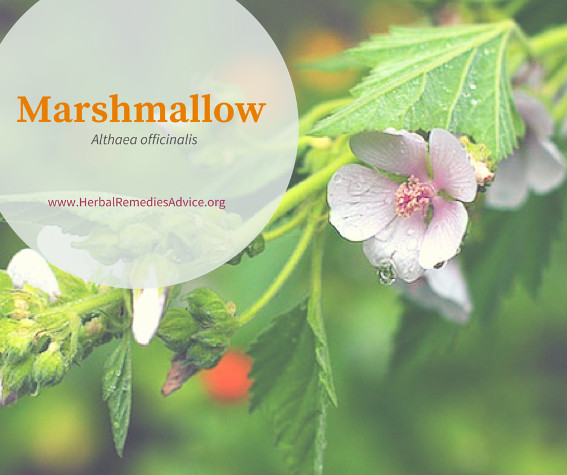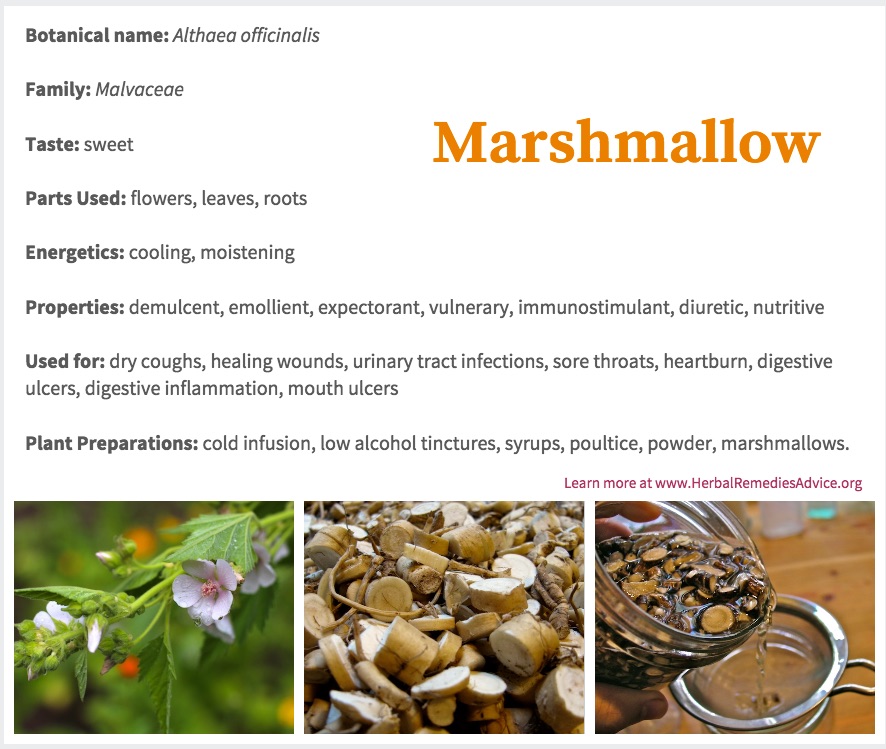Get weekly tips, recipes, and my Herbal Jumpstart e-course! Sign up for free today.
The Marshmallow Herb
Share this! |
|
Slippery, slimy, gooey… these probably aren’t words you associate with medicine, but sometimes they’re exactly what you need. And they perfectly describe the marshmallow herb benefits!
In fact, marshmallow (Althaea officinalis) is one of our most healing and soothing medicinal herbs! In this episode, I’m showing you exactly how to make a marshmallow root tea recipe for the best marshmallow herb benefits. Making this tea is so easy, you don’t even have to heat up water! (You can find the link for your free, printable recipe card in the section below.)
So… when might you turn to marshmallow root tea?
► To soothe your sore throat and/or dry spasmodic cough. Marshmallow root tea is cooling and moistening, a welcome balm to dry tissues.
► To address many kinds of inflammation in the gut. It’s ability to calm irritated tissues and promote healing makes marshmallow root tea a valuable ally when you need to modulate inflammation in the gut. (By the way, if chronic inflammation is a concern for you or a loved one, definitely check out my free, on-demand video training: ►►► http://herb-training.com)
These are just a couple of the possible applications for tissue-calming, healing marshmallow root tea… But there’s a lot more to know about working with the marshmallow herb, so be sure to tune in to the entire episode for all the goodies.
After listening in to this episode, you’ll know:
► How the marshmallow herb supports the body in fighting off pathogens
► The surprising way the marshmallow herb can aid a breast/chestfeeding parent
► Which medication for treating atopic dermatitis was outperformed by the marshmallow herb
► The marshmallow relative whose leaves and flowers are even more demulcent than marshmallow’s
► When and how to harvest marshmallow leaves and roots
► Who is NOT a good match for marshmallow
► Why the marshmallow herb can be great when you’re convalescing
► and more…
-- TIMESTAMPS --
- 00:00 - Introduction to the marshmallow herb (Althaea officinalis)
- 03:22 - Marshmallow herb energetics
- 05:18 - Marshmallow herb for the urinary tract
- 06:31 - Marshmallow herb for the cold and flu season
- 07:50 - Marshmallow herb for digestive inflammation
- 08:27 - Marshmallow herb for skin health, including healing wounds and soothing burns
- 10:48 - Other mallows
- 11:47 - How to identify the marshmallow herb
- 13:21 - Special considerations
- 13:58 - Marshmallow root tea recipe
- 18:11 - Herbal tidbit
Download Your Recipe Card and Ebook!
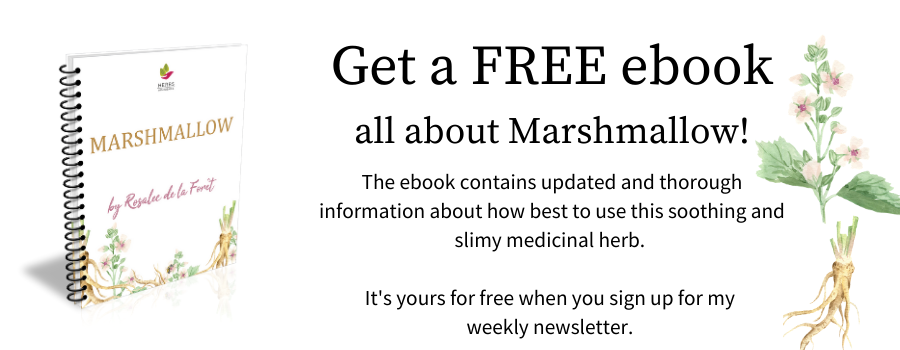
l
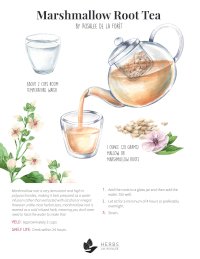
Transcript of the Marshmallow Herb Video
Like many herbs, marshmallow has a long history of use. While historical records show it was used as long as 2,000 years ago, it was undoubtedly used for thousands of years before that, both as a food and as a potent healing medicine.
The genus name for marshmallow is derived from the Greek word altho, which means “to cure,” thereby giving us great indication of how highly regarded this Althaea plant was in ancient times.
The marshmallow herb or Althaea officinalis is closely related to many other types of mallows, such as common mallow or Malva neglecta. These plants are often worked with interchangeably.
Pliny, a revered herbalist in ancient times wrote: "Whosoever shall take a spoonful of the Mallows shall that day be free from all diseases that may come to him."
Probably a bit of an exaggeration, but I love his enthusiasm for marshmallow!
Marshmallow is a popular plant too! Do you have experience with marshmallow root benefits? Do you love marshmallow root tea? Or are you trying it for the first time? I’d love to hear about it in the comments at the bottom of this page. Your comments mean a lot to me! I love cultivating a community of kind-hearted plant-loving folks! Plus, it’s always interesting and insightful to hear the experiences of plant lovers out there. Your suggestion may also help others!
Okay, let’s dive in..
Marshmallow Herb Energetics
Marshmallow root tea is slimy, slippery, and gooey, which admittedly may not sound super pleasant, but it’s exactly what you need when you are dealing with heat, irritation, and dryness.
Think of how soothing fresh aloe gel can feel on a sunburn. That’s what marshmallow can do, but is more typically used for dryness and irritation in the throat and lungs, the digestive and urinary tracks.
This soothing, cooling, and moistening action is called demulcent. And, marshmallow is revered in the herbal world for being an incredibly demulcent herb.
If you’re not immediately familiar with the demulcent action, I’m still certain it’s something you’ve experienced. Think of an old bowl of oatmeal and how it becomes thick and gooey. That’s demulcent!
Demulcent herbs are filled with polysaccharides which are long chain carbohydrates that become thick and viscous when soaked in water. The resulting brews of demulcent herbs are used to soothe hot and inflamed tissues.
There are about 1,000 different reasons for which you could use a demulcent preparation, ranging from ulcers and burns to dry coughs and inflamed tissues!
One of the best applications for demulcent herbs is to address inflammation caused by dryness. This is such a powerful way of working with herbs because instead of simply trying suppress inflammation, as is commonly done in western medicine, the demulcent action treats the actual dryness, helping to reverse this particular type of chronic inflammation.
If you’d like to know how to work with herbs holistically, to support your health from the ground up, then definitely check out my free training: How to Use Herbs to Transform Your Health to get More Energy & Vitality – Without Expensive Supplements or a Restrictive Elimination Diet.
You can access this free training at herb-training.com.
The Marshmallow Herb for the Urinary Tract
While it may make the most sense to use marshmallow directly on the tissues that need soothing, it also works systemically in mysterious ways. Herbalists commonly use marshmallow for hot and irritated conditions in the lungs and urinary system even though it never comes in direct contact with these tissues. Herbalist jim mcdonald explains:
Though it makes sense that demulcents coat tissues, the physical mucilage is actually very poorly absorbed by the body, and certainly isn’t traveling through the blood to the kidneys. Rather, the ingestion of mucilage seems to promote a systemic moistening of tissues throughout the body, with some demulcents being more specific to particular organ systems.
jim mcdonald
herbcraft.org
As a result it frequently gets used for hot and painful urinary problems such as cystitis, kidney stones, and UTIs. Besides being a demulcent specific to the urinary tract it is also a diuretic, which can be of further aide in many urinary problems.
The Marshmallow Herb for the Cold and Flu Season
Marshmallow is a wonderful ally for the cold and flu season especially for its ability to soothe an inflamed and sore throat. However, marshmallow goes beyond simply addressing a tissue state, it also stimulates phagocytosis, an important action of the immune system where phagocyte cells “chomp” on pathogens and waste material in the body.
Marshmallow is commonly used as a simple or in formulas to address dry and irritated lungs, which can result in spasmodic or hacking coughs or coughs with little to no expectoration. A review of the literature in 2020 confirmed what herbalists have long known: Althaea officinalis is effective at treating dry coughs.1
Recent research has also shown it to have mild antitussive qualities, but I never think of it as something used to suppress a cough, but rather as something to support hot and/or dry lung tissues to resolve a cough.
An interesting in vitro study concluded that teas made from marshmallow “are effective stimulators of cell physiology of epithelial cells, which can prove the traditional use of Marshmallow preparations for treatment of irritated mucous membranes within tissue regeneration.”2
The Marshmallow Herb for Digestive Inflammation
Marshmallow is almost always included in protocols for inflammatory problems in the digestive tract, such as ulcers, colitis, or dry constipation.
Besides being able to soothe inflammation, marshmallow root is also a vulnerary, helping to heal wounds within the digestive tract.
A marshmallow infusion can also soothe the painful sensations of heartburn (but a more holistic protocol such as dietary changes, astringents, bitters, and possibly antimicrobial herbs will be needed to address the root cause.)
The Marshmallow Herb for Skin Health, including Healing Wounds and Soothing Burns
Marshmallow root benefits include being a powerful healer for the skin. It’s long been considered a powerful topical treatment for wounds and burns. In the past it was called “mortification root” because of its ability to prevent gangrene.
While the marshmallow herb was used historically to prevent gangrene, you don’t commonly see it used for antimicrobial applications in modern herbalism. In addition to this historical use, modern day research is shedding light on marshmallow’s antimicrobial features. In a study which looked at 16 different herbs and their ability to address E. coli, a common gut and urinary tract infective bacteria, the researchers remarked that “Some of the results were unexpected. Althaea officinalis affected microbial metabolism in spite of the lack of literature precedent.”3
King’s American Dispensary, written in 1898 wrote:
Externally, marshmallow root is very useful in the form of poultice, to discuss painful, inflammatory tumors, and swellings of every kind, whether the consequence of wounds, bruises, burns, scalds, or poisons; and has, when thus applied, had a happy effect in preventing the occurrence of gangrene. The infusion or decoction may be freely administered.
Besides the roots, the leaves are also used as a fomentation or poultice to soothe rashes and other irritations of the skin. While herbalists commonly use cabbage leaves for easing the painful symptoms of breast engorgement during breastfeeding, marshmallow compresses, in addition to routine interventions (warm and cold compresses), have also been shown to improve breast engorgement.4
A 2021 pilot study compared the different between an Althaea officinalis cream and a hydrocortisone cream in children who had been diagnosed with atopic dermatitis. Marshmallow showed its healing abilities. The researchers concluded, “The results of this pilot study showed that the efficacy of Althaea officinalis 1% ointment in a decrease of disease severity is more than Hydrocortisone 1% in children with atopic dermatitis."5 That’s right, the marshmallow ointment out performed the hydrocortisone.
Preliminary research suggests that marshmallow may also protect the skin from UV damage.6
Other Mallows
Marshmallow is in the Malvaceae. This family name is derived from the Greek word malake, which means "soft." Almost all members of this family are used in similar ways to the marshmallow herb.
Members of the Malvaceae that you might be familiar with include:
- Roselle Hibiscus (Hibiscus sabdariffa)
- Chinese Hibiscus (Hibiscus rosa-sinensis)
- Rose of Sharon (Hibiscus syriacus)
- Cranberry Hibiscus (Hibiscus acetosella)
- Hollyhock (Alcea rosea)
- Common Mallow (Malva neglecta)
- Globemallow (Sphaeralcea acerifolia)
- Fanpetals (Sida spp.)
- Cotton (Gossypium herbaceum)
- Okra (Abelmoschus esculentus)
Malva neglecta, or common mallow, is a European and Asian weed that commonly grows in the U.S. and can be used very similarly to the marshmallow herb. One study showed that common mallow had higher mucilage in the leaves and flowers than other similar plants, including Althaea offcinalis.7
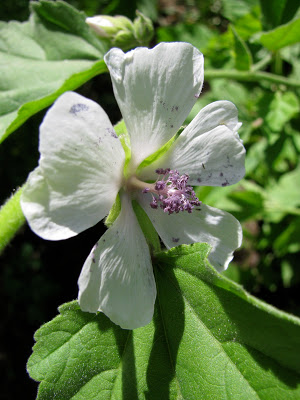
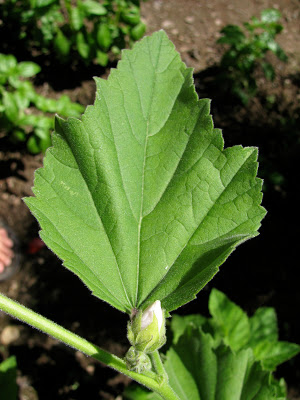
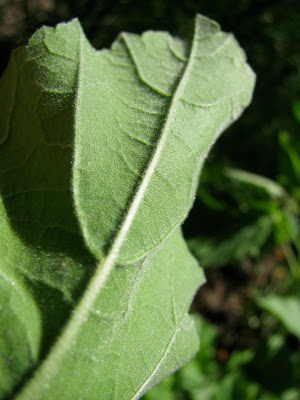
How to Identify the Marshmallow Herb
The marshmallow herb, Althaea officinalis, originally hails from central Asia, but is commonly grown all over the world. It loves to grow in salt marshes and is an easy herb to grow in your garden.
Marshmallow grows to about 3-5 feet in height. It’s a perennial herbaceous plant, meaning that it dies back in the fall and reappears in the spring.
Marshmallow flowers are pinkish to white and have five separate petals and many stamens. The stamens form a column around the pistil, giving it a distinct shape. (One study showed that antioxidant levels were highest in the white flowers compared to the pink.)8
The leaves are shaped like hearts with irregular serrations, and they are covered with small soft hairs.
The leaves and flowers can be harvested in the late summer to early fall. You can usually get two harvests of the leaves from the plant. Just before it goes to flower, cut the stems a foot or so above the ground leaving several inches of intact leaves in place. Depending on your growing season, the plant may branch and grow a second cutting of leaves.
Marshmallow roots are a pale yellow color and are tapered, long, and thick.
Marshmallow roots are harvested in the fall from the second or third year plants. They are chopped while still fresh and then dried. (Older marshmallow plants may have tough woody roots that aren’t ideal for herbal medicine.)
Marshmallow is considered safe for everyone to use although it is recommended to take it several hours away from taking prescription medications, as it may inhibit or slow the absorption.
Because marshmallow is so cooling and moistening it’s not advised to use it with conditions or people who are also cold and moist. If you’re new to understanding herbal energetics and how to match people and plants using the indications of hot, cold, moist, and dry, then check out my free mini course about the three essential skills to be an herbalist.
Marshmallow Root Tea Recipe
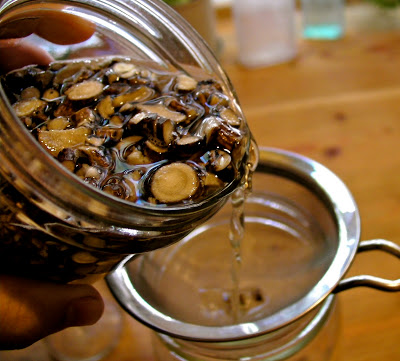
As mentioned, marshmallow root is very demulcent and high in polysaccharides, which makes it best prepared as a water infusion rather than extracted with alcohol or vinegar. However, unlike most herbal teas, marshmallow root is revered as a cold-infused herb, meaning you don’t even need to heat the water to make this!
To make this tea you’ll need
- 1 ounce (28 grams) mallow or marshmallow roots
- About 2 cups room temperature water
Add the roots to a glass jar and then add the water. Stir well.
Let sit for a minimum of 4 hours or preferably overnight.
Marshmallow roots are high in both polysaccharides and starches. By using a cold infusion you extract mainly the mucilaginous polysaccharides that are the demulcent constituents of the herb. If you simmer the root to make a decoction, you extract the starches in the plant, which is fine, but it will be less demulcent. The cold infusion is considered to be a more pure extract of the mucilage of marshmallow.
Don’t miss out on your free printable card for this Marshmallow Root Tea Recipe above this transcript!
If you enjoyed this video on marshmallow root benefits and you value trusted herbal information, then I hope you’ll stick around! The best way to get started is to subscribe on YouTube and your favorite podcast app.
One of the best ways to retain and fully understand something you’ve just learned is to share it in your own words. With that in mind I invite you to share your takeaways with me and the entire Herbs with Rosalee community. You can leave comments on my YouTube channel, at the bottom of this page, or simply hit reply to my Wednesday email. I read every comment that comes in and I’m excited to hear your herbal thoughts about marshmallow root benefits and this marshmallow root tea recipe.

Okay, you’ve lasted to the very end of the show which means you get a gold star and this herbal tidbit…
Marshmallow as a Healing Food
For many of us, the word marshmallow immediately makes us think of campfire, graham crackers and chocolate. And you’re right! Althaea officinalis was the plant that was originally used to make marshmallows before we ended up with the modern corn syrup version. However, unlike modern day marshmallows, the original marshmallow wasn’t just a sugary treat; instead it was a deeply healing food.
The roots of marshmallow are especially high in nutrients, and the young leaves and flowers are tasty in salads.
Marshmallow
root can be used similarly to slippery elm for people who are weak and
unable to eat many foods, as might be found in convalescence or during
cancer treatment. Hatfield Botanic Pharmacopoeia wrote this about
marshmallow in 1886…
In pulmonary consumption and other
wasting diseases it is one of the finest strengthening medicines to
which employment can be given; possessing so much nutriment that it may
with propriety, with the addition of milk, be taken as a food agreeing
with and remaining in the stomach when that organ has become intolerant
of other foods.
Citations for the Marshmallow Herb
Click to show/hide.

Rosalee is an herbalist and author of the bestselling book Alchemy of Herbs: Transform Everyday Ingredients Into Foods & Remedies That Healand co-author of the bestselling book Wild Remedies: How to Forage Healing Foods and Craft Your Own Herbal Medicine. She's a registered herbalist with the American Herbalist Guild and has taught thousands of students through her online courses. Read about how Rosalee went from having a terminal illness to being a bestselling author in her full story here.
